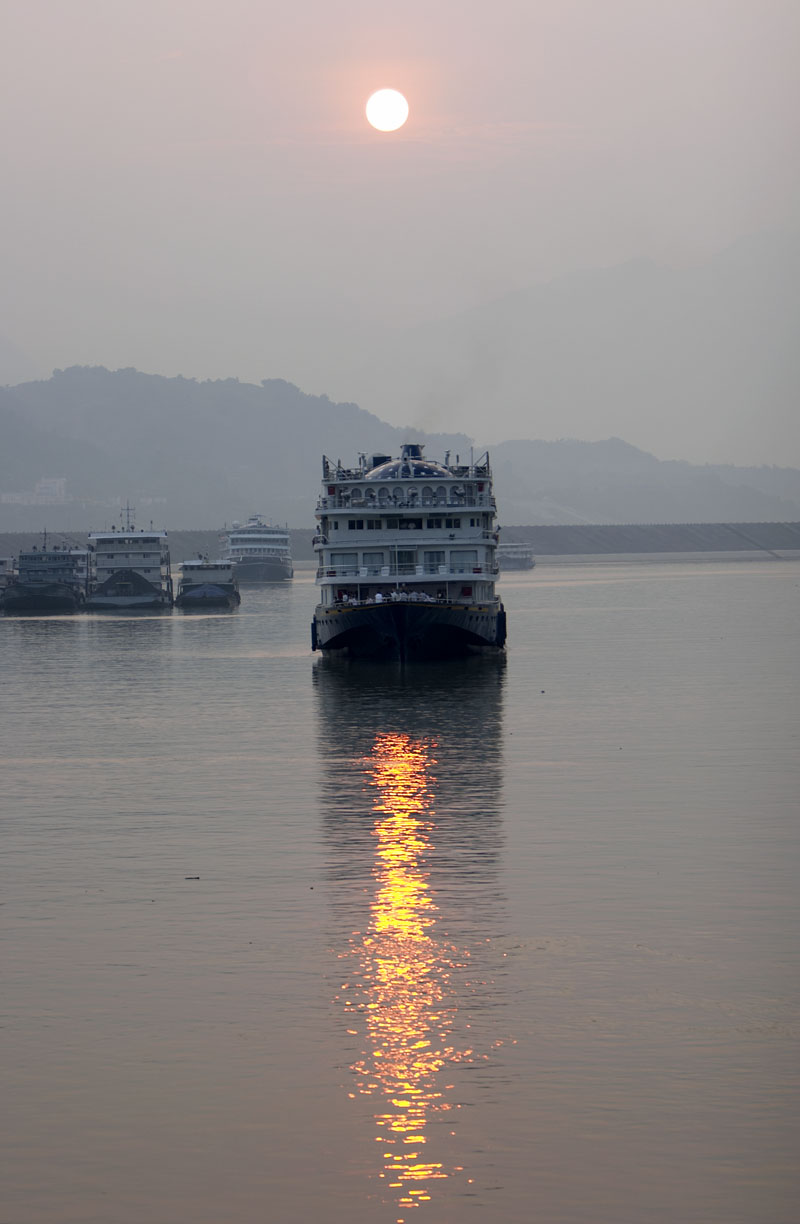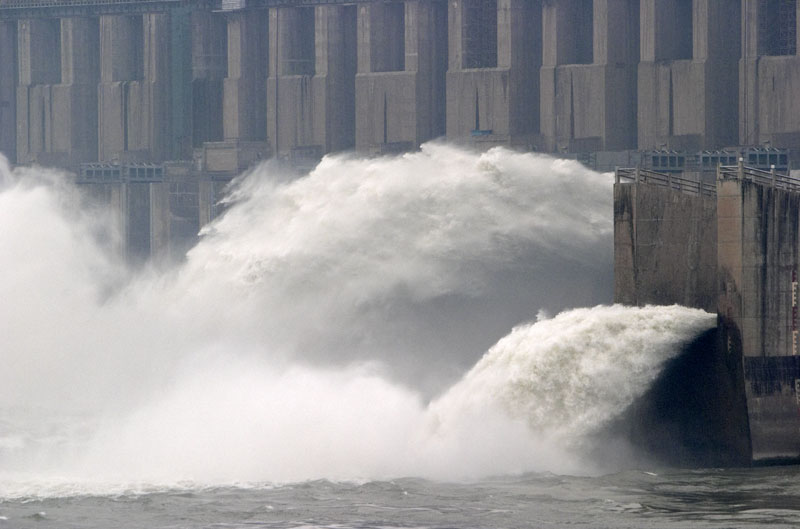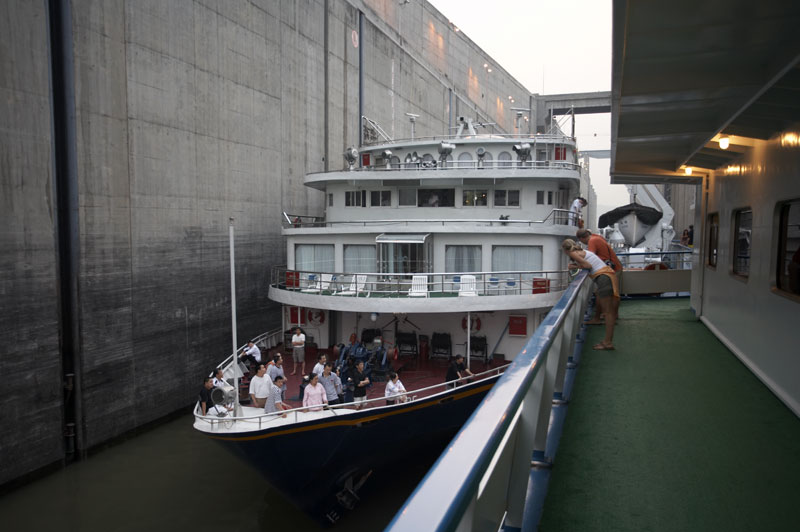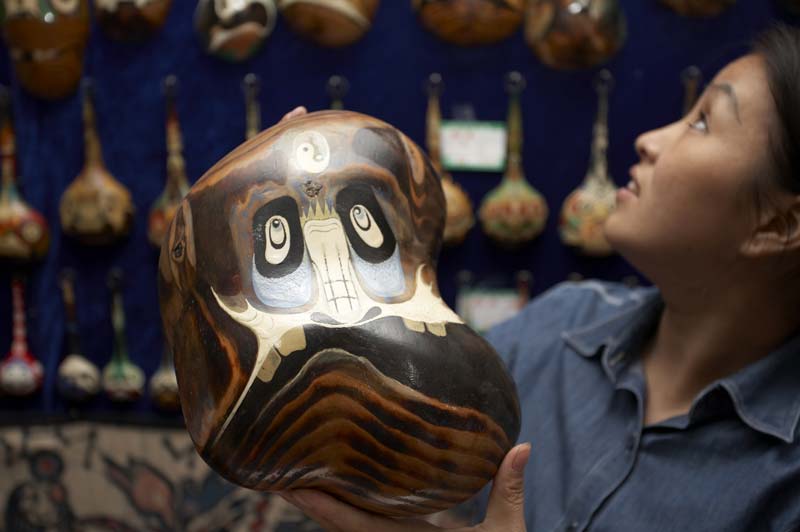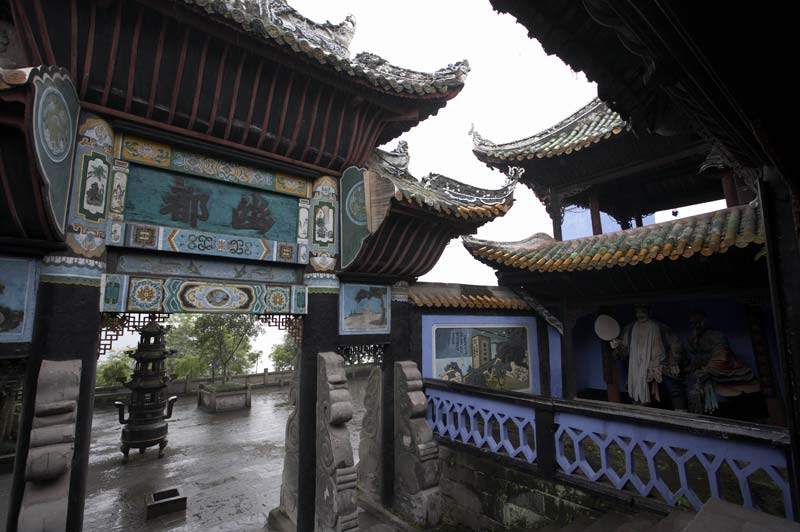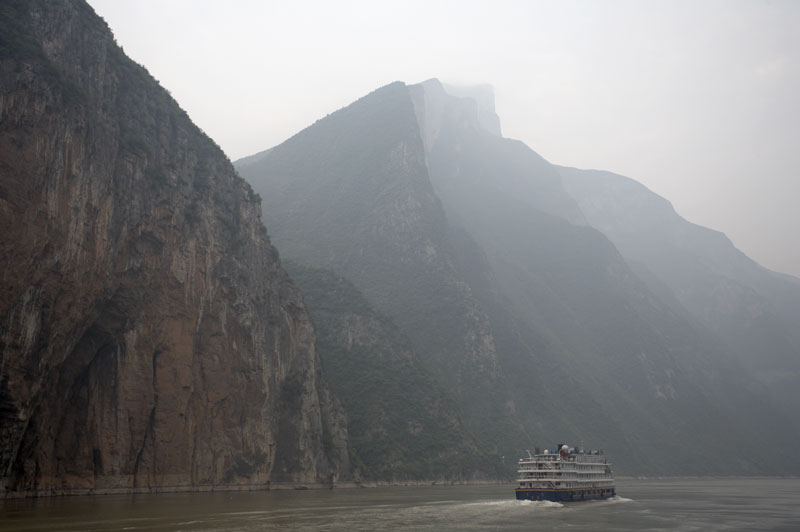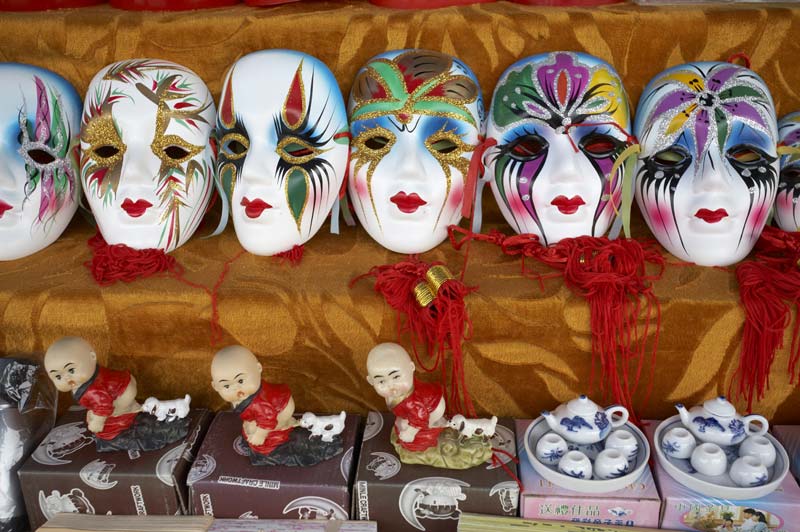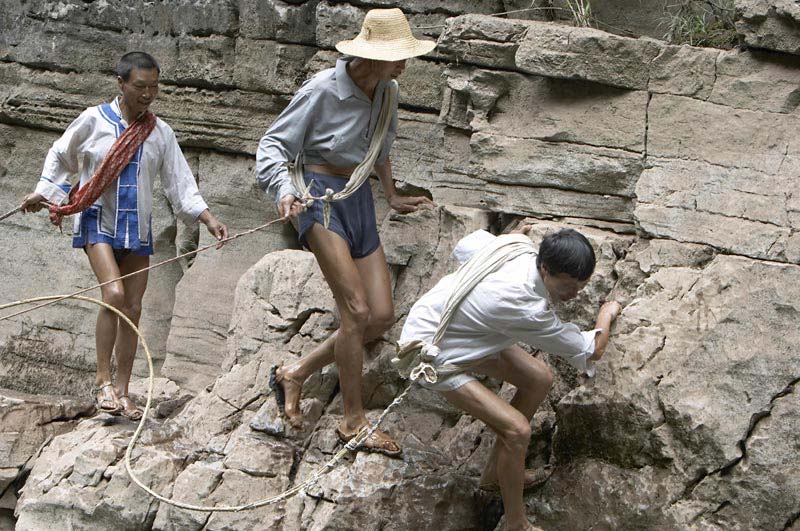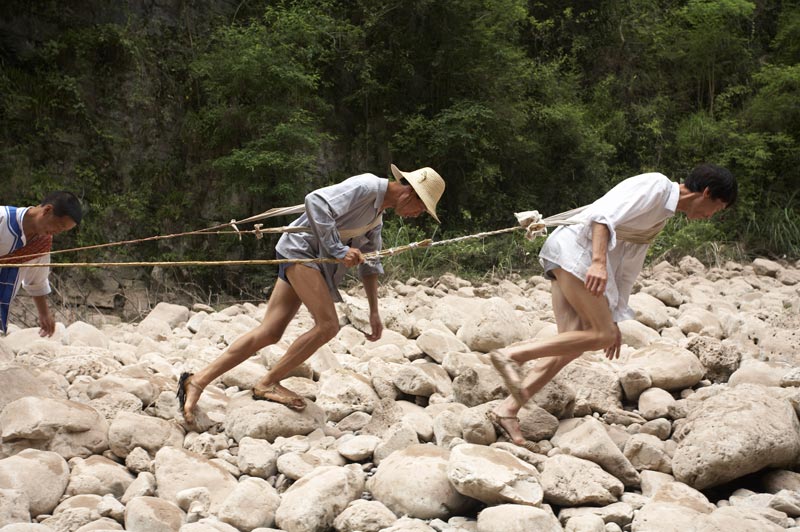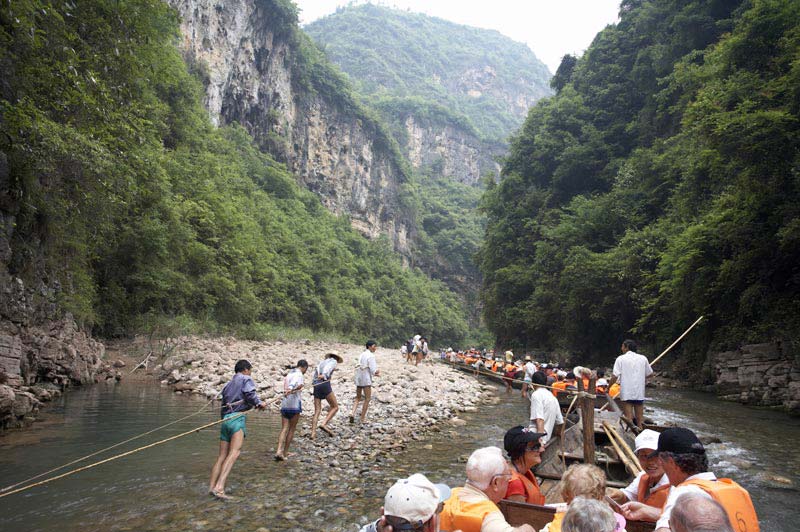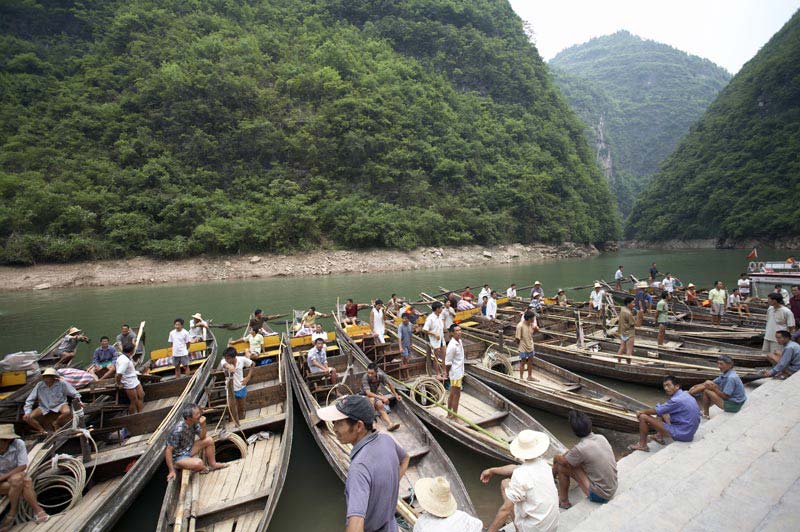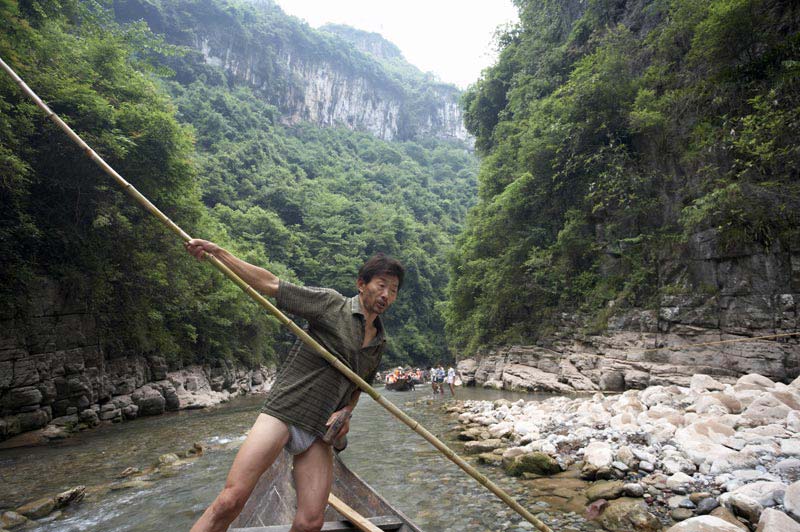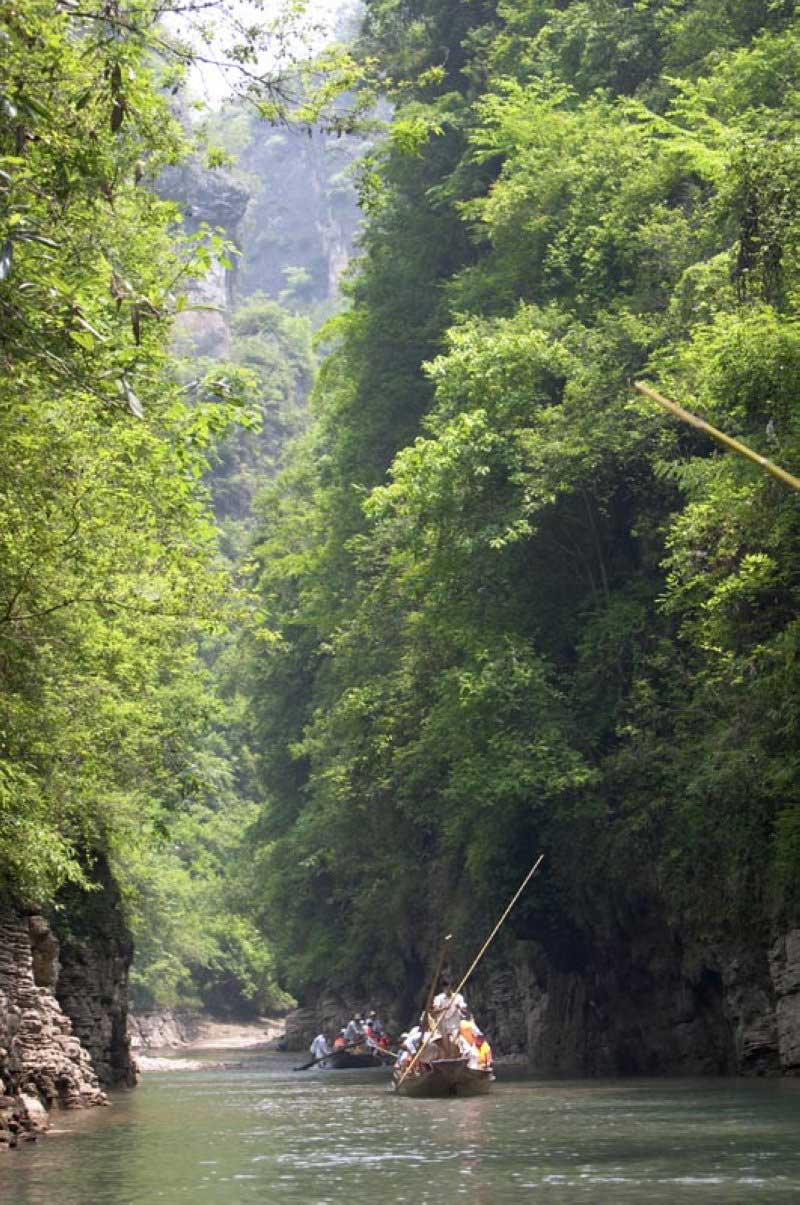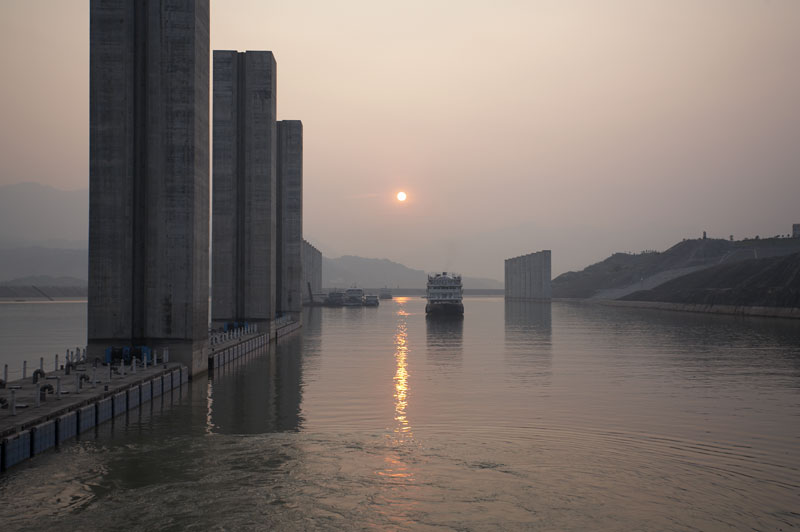When I went on a Yangtze River cruise, back in 2006, the Three Gorges Dam project was half-way through completion. Since then, China’s Three Gorges Dam project has tamed Asia’s longest river.
According to a famous travel quote by Chinese philosopher Lao Tzu, “A journey of a thousand miles begins with a single step”. I feel as if we’re taking our first “step” as the ship glides into the lock at Sandouping.
From the deck, I gaze back onto the river at the outline of the cruise ship behind us. A pale sunset peeps between towering grey walls, its reflection is a glossy echo shimmering in the Yangtze River.
Contents
Yangtze River Cruise
Most cruise ships pass through several interesting places to visit in China between Chongqing and Yichang.
Highlights of a typical cruise might include a few hours exploring Fengdu, a complex of temples in the Mingshan Mountain, and the Three Gorges Dam site at Yichang.
The dam was the biggest infrastructure project attempted in China since the Great Wall of China.
It’s five times bigger than the Hoover Dam.
The Three Gorges is a highlight and a controversial landmark in China.
In the Wu Gorge, deep valleys and misty tree-covered mountains are scenes from classical Chinese paintings.
Looking for more China destinations? Here are some things to do in Xian and things to do in Xiamen.
Yangtze River Cruise Highlights
Three Gorges Dam
It’s no surprise that the Three Gorges Dam project is a subject of intense interest.
Its construction is an extraordinary engineering feat, the biggest infrastructure project to be attempted in China since the Great Wall of China and the largest hydroelectric dam in the world (more than five times the size of the Hoover Dam).
Over the centuries, the 6300-kilometre Yangtze River, which snakes its way from the Qinghai-Tibet Plateau to the East China Sea, has both sustained as well as ravaged its people.
The Yangtze floods killed over 300,000 people last century.
Work on the dam began in 1971 and was completed in 2009, with the aim of achieving better control over flooding as well as supply power and water to the exploding population in China’s central west.
Locks on the Yangtze River
Another higlight is passing through the locks.
“That ship’s going to pull in right next to us,” says the man standing beside me.
From my vantage point, my eyes tell me there is not enough space for the second ship to fit without crashing into ours.
“I’ve worked out the numbers” he insists, rattling off measurements as he sees the doubt on my face.
“You watch; she’ll fit in there with a metre to spare,” he adds.
The conversation on deck is peppered with prattle about dams, reservoirs and power stations.
Glancing around, I realise I’m surrounded by maritime and engineering boffins whose wives and girlfriends have abandoned for more sensible shipboard pursuits, such as an hour or two at the beauty salon or an appointment with one of the Chinese masseurs.
As the other cruise ship glides easily into the spot next to ours, I head for the dining room to sip on chardonnay and nibble on beef stroganoff.
All up it takes about five hours for each lock, in turn, to fill up with ships, the gates to close and water to be drained out through underground chambers.
The view from the dining room porthole is almost futuristic – stark grey walls with numbers representing the water level in the lock flashing by.
Although it’s far from picturesque, it’s an experience I’m not likely to forget.
Since its inception, the project has been surrounded by controversy.
Over the years, the Chinese government has received a hammering over the future of the millions of people who will be displaced by the rising river and the loss of some archaeological and cultural sites, which are gradually being swallowed up by the rising water level.
Then there’s the ongoing pressure from environmentalists about the long term damages to the environment.
Chongqing
Chongqing is a city in central China with a population of over 12 million people.
“When they said it was in the middle of China, I was expecting a small fishing village!” comments a fellow passenger as we stare at skyscrapers and highways packed with late-model vehicles.
Fengdu
Our first day on the water brings us to the mystical ghost town of Fengdu, a complex of colourful temples nestled in the cliffs of the Mingshan Mountain, known as the city of ghosts in the ancient Chinese classic fable Monkey King.
I take the chair-lift to the sprawling collection of temples high up on the mountain.
The misty atmosphere is a perfect backdrop for lurking ghostly spirits.
Qutang Gorge
As dawn breaks the next morning, we sail through the first of the three gorges, the Qutang Gorge.
The magnificent Baiyan and Chijia mountains tower beside the ship, their peaks almost touching the sky.
Our river guide, Becky, talks about the gorge’s history, sights and landmarks.
We sail past spots already swallowed by the rising river, ancient plank roads, a rock formation known as Hanging Monk Rock and a Song Dynasty wall with political inscriptions.
On higher ground, farming plots and thatched huts are rapidly being replaced by factories and spanking new multi-storey apartment blocks.
In some sections, coal mining barges are being loaded with coal from cliffs above.
Dachang
Becky points out a tributary which leads to Dachang, a 1700-year-old town now submerged by the river.
Many buildings in Dachang were dismantled and rebuilt five kilometres away on higher ground and residents were forced to move out of their Ming and Qing Dynasty homes.
Dachang is only one of numerous towns and villages on the extensive resettlement list. Already, over a million people along the river have already been relocated to brand new towns.
For many along the river the relocation is a boon, an exchange of new accommodation for old. But there are still those, understandably, who are reluctant to embrace change.
Wu Gorge
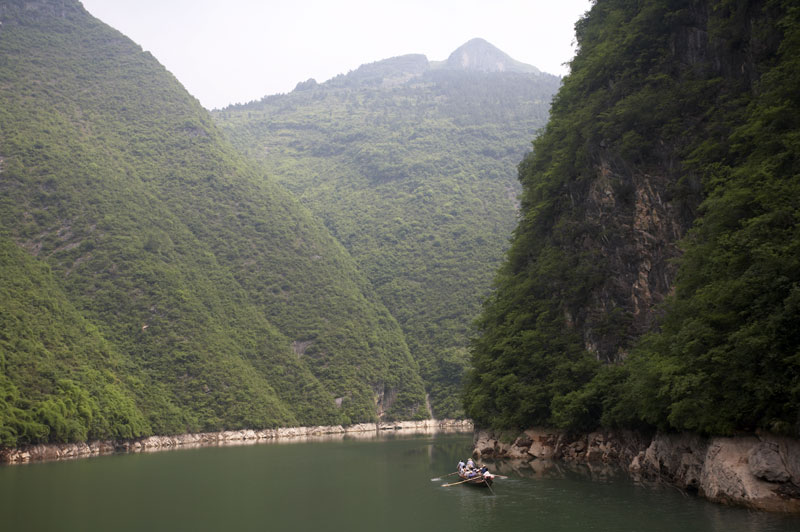
We zigzag slowly through the Wu Gorge where deep valleys and misty tree-covered mountains are scenes from classical Chinese paintings.
Also known as Witches Gorge, this gorge stretches towards the city of Wushan and is home to the famous Twelve Peaks.
Shennong River
At Badong we board a ferry for the Shennong River, which is a tree-lined tributary that joins the Yangtze River in the western part of Hubei province.
The Shennong Stream, which is a tributary of the Yangtze, joins the main river at Xirangkou in Badong, Hubei.
To put this in perspective, the Shennong stream is a trickle when compared to the mighty Yangtze River, which winds its way 6300km from the Qinghai-Tibetan Plateau to the East China Sea.
The water is so clear you can see the round coloured pebbles lying at the bottom of the river bed.
Before the invention of engines, naked Yangtze River trackers used towpaths to physically haul ships and junks along shallow sections of the river.
As many as 300 men would strip naked to heave a large ship against the current.
The men were strong and athletic and had muscles sculpted through years of hard labour.
They were known as the Tujia boatmen and would strip naked while working.
With ropes tied around the shoulders and waists, they would use manpower to heave these ships along the river.
The tracker’s job was once extremely dangerous as many sections of the river required workers to balance precariously on the side of a sheer cliff where one misstep could plunge a man into the swirling current.
These days, their cargo consists of life-jacketed tourists.
Along this tributary are the hanging Ba coffins which are wooden burial boxes with village elders laid to rest in caves half way along the cliffs.
From the river, these coffins can be seen jutting out of caves, some as high as 30m above the level of the river.
A rowboat tour is a fun way to explore this part of the river and to learn about the culture.
We boarded a ferry at Badong and cruised along the tree-lined tributary of the Yangtze River.
The was plenty see along the way, such as cliffs overgrown with lush foliage and bat-filled caverns.
Hanging high above the river were wooden boxes wedged into small holes in the cliffs.
These boxes are coffins of the Ba elders, a minority group who lived in these mountains for thousands of years.
The ferry dropped us off at a jetty, where there were rows of long timber skiffs (known as peapod boats).
These hand-crafted vessels were built by local craftsmen; a skill passed on from generation to generation.
The boats looked sturdy enough to withstand the surging river currents.
The Tujia boatman weren’t exactly naked. They were wearing shorts, shirts and straw sandals.
We climbed into the peapod boats and there was a shout from the main boatman and we pushed off – an armada of tourists seeking adventure along a shallow tributary of the Yangtze River.
We glided past cliffs that reached towards the sky.
The water was still and the reflections of the trees in the forest was calming.
My boatman steered with a long bamboo pole.
He was lean and wiry from years of labour. His skin was leathery.
In the past, he used to earn a living as one of the men who would strip naked to pull those big ships along the river.
The reason they worked without clothes was the fabrics chafed their skin and wet clothes could cause chills.
Working the tourist beat is a lot easier and far less dangerous.
He steered the boat towards a ledge and three men leapt out.
They scrambled along the rocky ledge, walking along the tow path with bamboo ropes around their waists and shoulders.
They ran until the ropes took up the slack, pulling us through the shallows.
The tributary was indeed shallow. The pebbles on the riverbed were so close to the surface I could reach down and touch them.
In the past, peapod boat captains were highly respected and the position was fiercely contested among the men.
Potential captains had to prove they were worthy of the task by navigating dangerous rapids and most captains would have ad at least 10 years as a crew member.
At the end of our journey, our boatmen broke out into a haunting melody. Listening to them sing lifted my heart.
Xiling Gorge
On our last day on the river, sailing through the Xiling Gorge, we arrive in Yichang, an ancient city with thousands of years of history, now home to the site for the Three Gorges dam.
At the dam site there’s an information centre with a mini-scale model of the project. Outside the centre, landscaped gardens with green lawns, bright flowers, water features and sculptures complete the picture.
At one section, we’re even able to look down into the ship locks.
The image which remains in my mind’s eye is the powerful water jets gushing out of floodgates, a reminder of the raw power of the mighty Yangtze River.
Plan Your Trip

Rent A Car – Find the best car rental rates at Discover Cars. They compare car hire companies to provide you with the best deal right now.

Find A Hotel – If you’re curious about this article and are looking for somewhere to stay, take a look at these amazing hotels.
